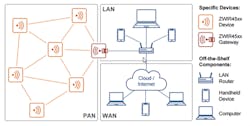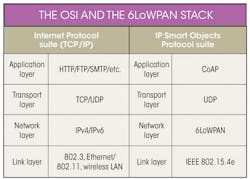Download this article in PDF format.
Linking all kinds of different sensors and devices together is the overarching goal of Internet of Things (IoT) technologies. But the Internet Protocols (IP) required to achieve this goal create energy burdens for battery-constrained and very-low-powered sensors and devices. That’s why 6LoWPAN was created, to enable IP communication with even the lowest powered and smallest of things – such as IEEE 802.15.4 devices.
Sponsored Resources:
- Future-proofing with 6LoWPAN-based IoT Sensors
- ZWIR4532 6LoWPAN Wireless Module for IoT Sensor Networks
- Sensing Technologies and Sensor Solutions
Basics of “AN”
The acronym “6LoWPAN” is a combination of the latest version of the Internet Protocol (IPv6) and low-power wireless personal-area networks (LoWPAN). IPv6 is a major data-delivery format for local-area networks (LANs) and wide-area networks (WANs) that form the majority of internet connections (see figure).
6LoWPAN modules (left side) are connected to other IP networks through edge routers. Together, these IP networks enable easier sensor networking. (Courtesy of IDT)
The 6LoWPAN standard ensures that any low-power radio can communicate to the internet, e.g., 804.15.4, Bluetooth Low Energy, Z-Wave (for home automation), and others wireless protocols. The IEEE 802.15.4 is a technical standard that defines the operation of low-rate wireless personal-area networks (LR-WPANs) and is a basis for Zigbee.
Originally, the Zigbee standard was designed to be an automated local bus with no connection to the internet. 6LoWPAN helps to extend Zigbee with a low-power interface to the internet via appropriate protocol stacks. Specifically, the 6LoWPAN protocol utilizes encapsulations and header-compression mechanisms that allow IPv6 packets to be sent and received over IEEE 802.15.4-based networks.
The key point is that with 6LoWPAN, all devices—even the lowest-powered sensor—can communicate with the same IP protocols and applications as used anywhere on the internet, from the home to the factory floor and the entire world.
For example, today’s smart thermostats can “talk” to the light, blinds, vents, and even security systems, all of which are controlled via a mobile device. Further, since the communication protocol is an IP-based open standard stack (without any proprietary protocols), there’s much less wireless signal interference between all of these devices—a plus for consumers and factory floors.
Key 6LoWPAN Features
As mentioned, 6LoWPAN provides communication between low-power devices and the vast world-wide-web network based on IP protocols. It does so using standard routing techniques that turn IEEE 802.15.4 low-power sensor devices into IP-enabled links. IEEE 802.15.4 carries information on radio transceivers at 2.4 GHz—roughly the same band as Wi-Fi but using about 1% of the transmission and reception power. Low-power sensors typically have access to less that 1mW radios.
How does 6LoWPAN support low-power IP-based connectivity? The primary way is by shrinking bulky IP headers. Before 6LoWPAN, a complex application gateway was needed to make devices such as Zigbee, Bluetooth, Z-Wave, and proprietary systems connect to the internet. This power-intensive approached was improved by adding network layers to enable transmission of IPv6 data over IEEE 802.15.4 radio links (see table).
IP transmissions over IEEE 802.15.14 radio links are enabled by adding an adaptation layer (not shown in the table) between the IP stack’s link and network layers of the open systems interconnect (OSI) model.
6LoWPAN protocols compress standard TCP IP headers into small packets that carry only the bare essentials through a process known as header compression. TCP is the dominant transport protocol on the internet. It’s a connection-based protocol that contains a large overhead. Conversely, UDP (User Datagram Protocol) is a connectionless protocol with a much lower overhead that provides ultra-low-power consumption. Using UDP eliminates redundant or unnecessary network-level information in the IP header between various 802.15.4 devices on the sensor network.
Further, transport layer security (TLS) running on top of TCP is based on UDP protocols. This ensures robust security for 6LoWPAN applications.
Along with lowering power via header-compression transmissions, shrinking the actual size of the 6LoWPAN chips allows for wider adoption in the ever-smaller embedded devices that make up the IoT. For example, wearables are typically small and lightweight devices that offer little room for chipsets and antennas.
Challenges Remain
While 6LoWPAN offers a low-power bridge to non-IP wireless network protocols such as Zigbee and Z-Wave, technical skill and engineering knowledge is needed to make OSI model, application layer changes to accommodate any software updates to these networks.
In addition to software updates, another challenge facing IoT designers is the changing of hardware devices across a network. For example, sensor nodes and end devices may be added, removed, or moved around on the network. Integrating different hardware and software across the network can cause many configuration errors.
These problems are addressed by IDT’s SensorShare, a software platform in hardware systems designed to be an open standard that connects device-to-device, device within a local network, and device-to-cloud configurations. On the cost side, SensorShare is offered with no license fee and has no royalty fee.
SensorShare is an optional 6LoWPAN-compliant, open standard firmware stack that communicates natively with IPv6 over IEEE 802.15.4 radio links. It removes the need for IoT designers to deal with sensor and device changes that occur throughout the network.
The firmware works with the ZWIR4532 chipset—containing an Arm microcontroller, a sub-gigahertz radio transceiver—to provide IoT connectivity to even the lowest power sensors. It’s well-suited for embedded, IoT consumer, industrial, and medical devices where power and space are a constraint.
Summary
The IoT requires that even the lower-powered sensors and devices be connected to the internet, which means communicating via the IPv6 protocols. The challenge is that sensor networks are often energy-constrained and wirelessly connected via IEEE 802.15.4 networks like Zigbee and Bluetooth that don’t natively support IPv6. IDT now offers the ZWIR4532 connectivity module (sub-1-GHz), a programmable low-power secure IPv6 communication module for IoT applications. An optional SensorShare firmware stack provides open protocols that communicate natively with IPv6.
Sponsored Resources:


